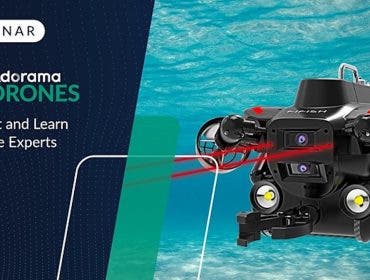Photography has many technicalities that may seem challenging to grasp at first. But learning is part of the job, and each concept takes you closer to materializing your artistic vision into great photographs. The hyperfocal distance could be the next step if you are familiar with aperture, depth of field, and minimum focus distance. Although it may seem a complicated concept, it will become second nature once you figure it out. Also, it will help you achieve the depth of field you need without compromising camera settings or composition.
Especially if you love landscape photography or cityscape photography, knowing how to measure hyperfocal distance will come in handy. It helps you create those crispy sharp images. However, controlling the depth of field is useful regardless of your preferred photographic genre. So, here is everything you should know about hyperfocal distance and how to use it to your advantage.

What is Hyperfocal Distance?
In photography, the hyperfocal distance is the focusing distance that gives the maximum depth of field possible. Setting the camera to focus on a point at this distance allows you to have the entire frame sharp and clear.
The hyperfocal distance has two very similar definitions and measurement methods. As the difference between their results is small, you can choose whatever definition and method seem more comfortable to you.
First Definition
The hyperfocal distance is the closest distance at which a lens can be focused while keeping objects at infinity acceptably sharp.
Second Definition
The hyperfocal distance is the distance beyond which all objects are acceptably sharp, for a lens focused at infinity.
In other words, there is a focal point between the foreground and background that allows both of them to be in focus. The distance from the camera to that point is called hyperfocal distance.
You’ve probably noticed that both definitions include the word “acceptable.” The criterion for what acceptably sharp means is given by the circle of confusion diameter limit (CoC limit), which is the largest blur spot the human eye perceives as a point. To makes things easier, the CoC limit is often associated with image formats. The CoC limit is 0.029mm for a full-frame sensor while for an APS-C sensor it varies between 0.018mm and 0.023mm.
The circle of confusion diameter limit depends on visual acuity, viewing conditions, and image enlargement. For example, if you enlarge an image too much, it will become blurry. If you preview a blurry image on a small monitor, you might consider it sharp, and so on.
It is not a precise measurement, but perfect sharpness is impossible. However, you’ll see that the CoC limit is enough to fool the human eye.
So, if you consider hyperfocal distance when taking a picture, much of the picture will be made of very small circles perceived as points by the human eye. It will be considered sharp in almost all cases.
How Do You Measure Hyperfocal Distance?
There are two formulas for computing hyperfocal distance, one for each definition.
For the first definition, the formula of hyperfocal distance is:
H= f^2/Nc+f
H is hyperfocal distance, f is focal length, N is the f-number (aperture), and c is the CoC limit.
For the second definition, the formula is almost the same; you just remove the focal length at the end of the formula:
H= f^2/Nc
Let’s try with an example using the second definition.
So, for instance, if you use a full-frame camera, c is 0.029mm. With a 100mm lens and an f/4 aperture, the hyperfocal distance is:
H= 100^2/(4*0.029)=86207mm
As a result, you will get a hyperfocal distance of 86m. This is where you should focus to maximize the depth of field all the way to infinity with this focal range.
Using the same full-frame camera, 100mm lens, and f/4 aperture and focusing at approximately 86m, everything from half that distance (43m) to infinity will be acceptably sharp.
If you instead, use an 18mm lens, everything beyond 2.8m will be acceptably sharp. Hence, your decision on using a telephoto or a wide lens.
For any possible focal length and aperture, the difference between the two methods is of the order of centimeters.
Because most photographers will never use formulas during a photoshoot, many lenses have marks for their hyperfocal distance or range. For example, a Nikon Nikkor 28mm Lens indicates the hyperfocal range for specific apertures using an orange dot. However, you can also use hyperfocal charts and apps as mentioned below.

Using a Hyperfocal Distance Chart
Hyperfocal distance charts are shortcuts for finding the hyperfocal distance for any type of sensor, focal length, and aperture. They are pre-calculated tables that provide hyperfocal distances for all combinations of camera models, lenses, and apertures. You can print a static chart for your camera model or use a real-time calculator provided by the camera manufacturer to address multiple camera models.
To use a hyperfocal distance chart, you have to decide on a set of settings (sensor type, focal length, and aperture) and read the resulting hyperfocal distance in the table. Because you don’t often change the sensor type, you can reduce the search to two variables: focal length and aperture.
As you can see from the formulas above, the bigger the focal length or smaller the f-number (larger aperture opening) is, the longer the hyperfocal distance gets. Therefore, with telephoto lenses, you will have a shallow depth of field when focusing on subjects close to the camera. To increase the depth of field, you have to focus at a longer distance and, therefore, have a longer camera-subject distance.
On the contrary, lenses with short focal lengths and large f-numbers (closed down aperture opening) produce a shorter hyperfocal distance. As a result, you will achieve a deeper depth of field with a much closer focal point. As a result, you will be able to have a subject in focus close to the camera and a faraway background also in focus.
Setting Yourself Up
So, first, decide what lens you have to use to cover the distance between the camera and the subject. Then, search the hyperfocal distance chart for the aperture that gives you the correct hyperfocal distance.
You can also use the chart to determine what aperture you need for a particular hyperfocal distance. Or what focal length you should use for a fixed aperture. Adapt the use of the chart to available lighting conditions and composition decisions and vary the parameter you can afford to change.
Instead of using a physical hyperfocal distance chart, you can also opt for using a hyperfocal distance calculator for your smartphone, where you dial in your settings and distance to your foreground. The app will then tell you where you should focus.
When to Use Hyperfocal Distance
Working with hyperfocal distance helps you have both foreground and background in focus when there is a long distance between them. Therefore, to be worth the use of the measurement, you first have to have interesting elements in the front and back of your scene.
The measurement is often used by landscape and cityscape photographers. That’s because their scene is deep — often includes the horizon — and has to be entirely sharp. In addition, including an element in the foreground gives a sense of depth and makes the landscape look realistic. Thus, landscape photographs meet the conditions for using hyperfocal distance most easily.

However, you could consider using hyperfocal distance even when the scene is less deep than a vast landscape. Sometimes, the distance between foreground and background translates into a shallow depth of field, even if it isn’t a very long distance. As a result, you have to decide whether to have a clear background or foreground. If both are beautiful and add value to your visual story, find the hyperfocal distance and take a shot. You can experiment with different depths of field and see which one suits your composition.
You should also consider using hyperfocal distance when you have multiple subjects scattered at different distances from the camera or leading lines going towards the horizon. Any scene with a strong connection between foreground and background (visible or intuitive) should have both of them in focus.

Concluding Words
Using hyperfocal distance with formulas and charts is a matter of practice. You’ll be able to approximate it very soon or develop your own method. Some photographers start by doubling the distance to the closest object they want in focus. Others focus at infinity and then focus closer and closer until they are satisfied with the result. There are situations when it is better to determine the precise hyperfocal distance you need, and then find the aperture that gives you that distance. In time, you’ll know what works for you. However, it doesn’t hurt to have a chart or an app at hand just for a quick check.






